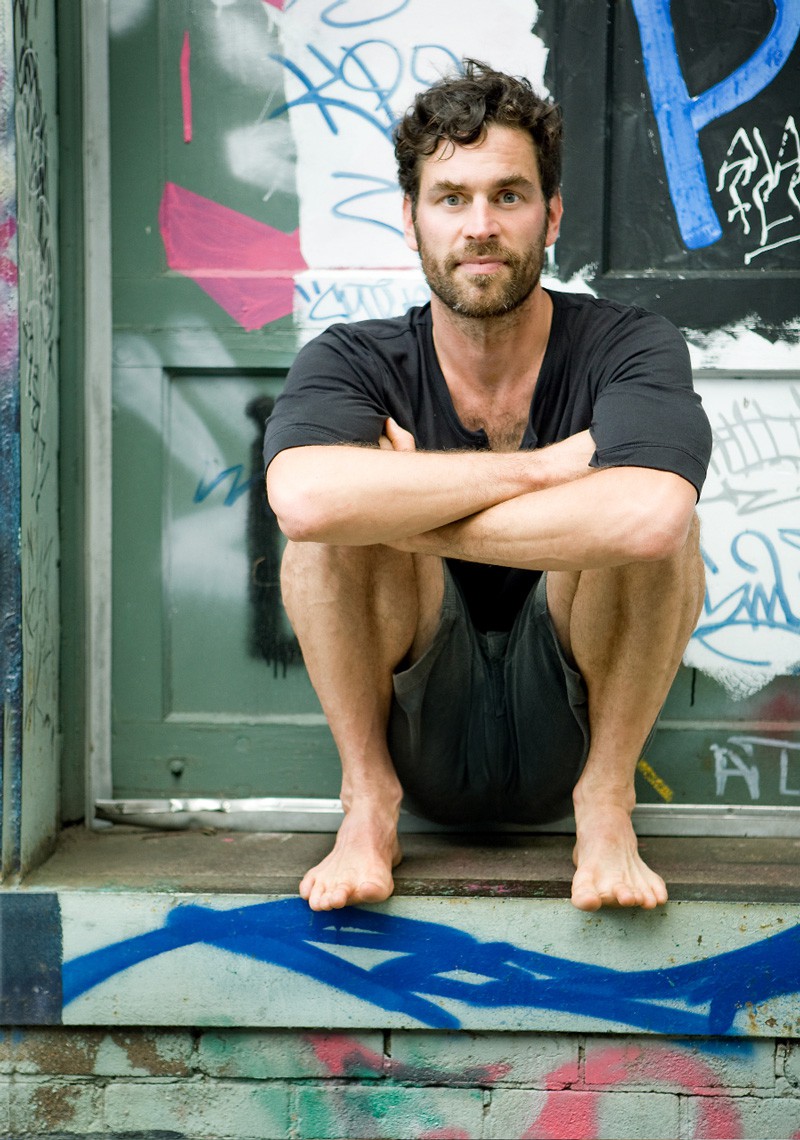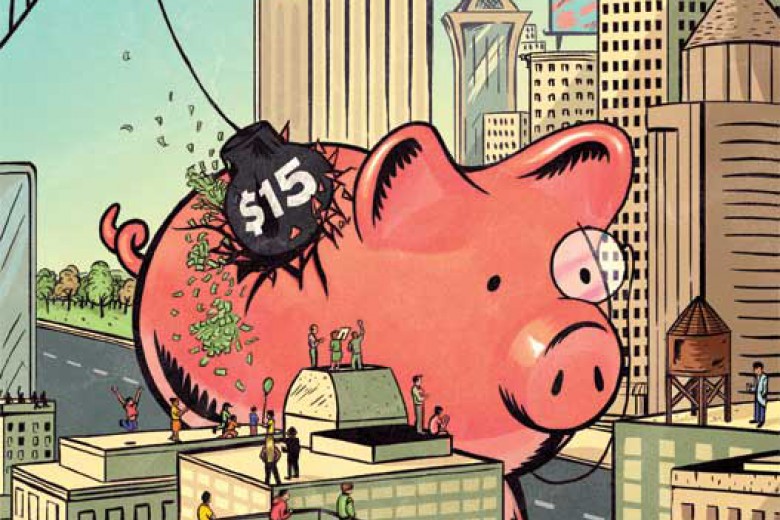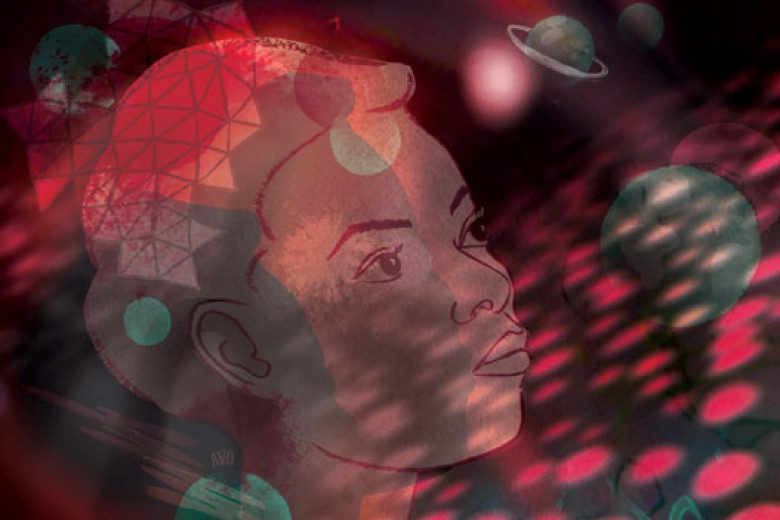
Many activists practice yoga, but few would describe their yoga practice as a form of activism or treat their activism as an expression of their yoga practice. Michael Stone is working to change that.
An unapologetic misfit in almost any category, Michael Stone is a non-practicing psychotherapist, a devout iconoclast, a dissident Buddhist and a yoga teacher whose students won’t wear lululemon clothing to class for fear of being teased. His work at the intersection of yoga, Buddhism, psychotherapy, ethics and social action is refreshingly direct, pragmatic and free of dogma. He heads the thriving Centre of Gravity sangha in Toronto, and is the author of several books, including Yoga for a World Out of Balance: Teachings on Ethics and Social Action.
Michael joined me for breakfast at the end of a weekend yoga intensive in Regina, Saskatchewan. The din of a crowded brunch joint on a Sunday morning, elbow-to-elbow with dressed-up church-goers and hungover hipsters, seemed a fitting backdrop to our conversation, which explored the ways that neither ethics nor politics can be separated from the everyday experience of living in a community, with all the contradictions and accommodations that entails.
I’ve read estimates that one in 20 Canadians now practice yoga. To what do you attribute yoga’s growing popularity?
People come to yoga practice because they want to pause; they want to get settled. In a culture dominated by attention deficit and hyperactivity, people want to learn how to pay attention.
As we start to go deeper into working with the body and mind, we realize that we are all haunted by a sense of lack. In yoga and in Buddhism, this is called dukkha, which often gets translated as suffering, but psychologically it refers to this sense of lack we all feel. At a psychological and social level, dukkha is the inability to be content. We feel it because the self is not a fixed thing. It’s a psychological and social construct; it’s just a story that we tell ourselves. It can’t ever be grounded.
When we feel that sense of lack, we begin to look for ways to fill it: we think that if we shop for just the right item, or become famous, or accumulate enough capital, or fall in love with the right person, we can fill that emptiness. But none of those things work; they only serve to increase the lack.
What yoga reminds us is that we are all interconnected and that there’s no such thing as a “self” that’s separate from any other thing. The self is a relational process. So if we focus our actions and ambitions on creating independent, atomized versions of ourselves, we will never find ease. If you look at the most contented people around you, you’ll see that the ease they exhibit is actually a peaceful and creative engagement with the world.
You speak of yoga as an ethical or spiritual practice, but many people see it as just an exercise program. Is that a misconception?
Well, I’m sympathetic to people who come to yoga as a way to connect with their bodies. We live such cerebral, indoor, virtual lives that to learn how to stop and connect with our bodies can actually be a way to connect to something much larger. You could even say that giving attention to the body nowadays is a step towards some kind of wholeness.
It’s too easy to dismiss yoga as just a narcissistic form of physical exercise, which of course it can be, but so can anything else. There is some part of us that wants to be fully present, that’s not just interested in relating to people electronically or maintaining a fixed image of ourselves, that instead wants to drop into what it actually feels like to be in a body, to be a citizen, to be part of this ecological sphere. Connecting to the body politic in a way that is grounded and creative begins with my own body and how it’s looked after, and whether I too am awake.
In your book Yoga for a World out of Balance, you refer to yoga as “a system of education more than a religion.” Why is that distinction significant?
I’ve always appreciated that the yoga texts don’t start from any particular belief system. Rather, they suggest that by giving attention to the way things are right now, in this body, in this gender, in all the complexity of this culture, we come to see that this is all we’ve got, and so this is what we work with.
Yoga is a process of waking up out of the self-created habits that keep us in exhausting patterns of addiction. Through yoga, we continually come back to ourselves through the study of our ethical commitments, our minds, our relationships. We begin to see that yoga allows us to see the inherent intimacy of all life.
Instead of starting from an answer, we start from valuing questioning, we start from doubt, we start from inquiry. Rather than starting from a position that says there is life after death, or there is a creator-god, all of that is bracketed and put aside. We start from what’s right here in our lives at this time; we value present experience rather than ideological frameworks. In that way, yoga is more of an educational process than a religious system. It’s more ground-up.
There are no yoga temples, and you can’t find yoga priests. Yoga doesn’t belong to a particular religious system or educational form, and that’s why it can be accessed by so many people. This resonates with my reading of the Buddha’s teachings. Throughout his life he worked on the psychological level, but he also valued city life and was fully engaged in the social, economic and political reality of his time. He never dropped out; he dropped in.
Yoga is an anarchic practice. It thrives in the alleys, because alleys are the places where people leave their systems behind and hang out together and create in a way that’s more alive than what’s taught in a classroom. So if you imagine there’s a church and a school and Briarpatch Magazine and a hospital, and at break time everyone goes into the alley and hangs out and talks — well, what’s more alive is not what happens in those institutions, but what happens in the alley.
Many people, especially activists, can get so caught up in constant judgment of themselves and others that they burn themselves out, or burn bridges with those around them. Does yoga have a role to play in fostering effective activism?
The first precept or ethical commitment of yoga is ahimsa, which can be translated as non-violence or not having the intention to cause injury. What I’ve always liked about the framing of that precept is that it’s about a negation of violence, which presupposes that there’s already violence. So instead of the first principle being peace, which is perhaps too idealistic, the first principle is to live a life committed to non-harming within the context of an imperfect society in which violence is in us and all around us.
One of the first teachings on non-violence is non-violence to self, which recognizes that you can’t really act towards others in a way that’s non-harmful if you’re hurting yourself. Self-judgment is one of the most common ways we hurt ourselves. It takes the creative energy that fuels us and turns it into a negative dead-end pattern that we repeat over and over.
If we really understand what a commitment to non-violence is from a psychological perspective, then we understand that it begins with ourselves, with valuing who we are, valuing even our privilege, so that we don’t critique ourselves to the point of indecision and paralysis, and can instead respond to what is needed with creative, spontaneous action.
Michael Lerner talks about this in his book Surplus Powerlessness, where he says that a lot of activists’ psychological problems, their feelings of impotence, have to do with the fact that we are not just powerless when confronted with violence from above, but we become powerless by judging ourselves. Having a negative self-image is a kind of surplus powerlessness that we also need to work with. We have to do that inner work or we fall prey to activist bypassing, which is using our outer work of transforming the world as a way of avoiding deep internal work that also needs to get done.
But doing this work requires some technique. That is why meditation practice and yoga postures and breathing practices are so helpful, because they teach us how to slow down and pay attention to what’s actually happening in this moment rather than what we think should be happening or what we want to happen.
Some activists view Gandhian non-violence with suspicion. They point out that one of the luxuries of power is that violence from above is often invisible, or even celebrated as heroism, whereas the defensive violence of those at the bottom is met with outrage and condemnation, while their peaceful protests are praised and their demands are ignored. In a violent world, how does working from a strict commitment to non-violence not just serve to reinforce an unjust status quo?
First I want to emphasize that ethics, according to the yoga tradition, is not a top-down process. Instead of saying, “commit to these 10 ethical precepts so that you can lead a life that is more awake” we understand ethics inversely, where because we recognize that we are so interconnected, ethics arises naturally.
I understand non-violence more as a way of focusing our intentions rather than as some political commitment, because I don’t know what that would look like. I don’t know what non-violence means except in each situation. In one situation, in one context, what seems harmless may be quite harmful in another context. I have to suspend the story I tell myself about a particular situation so I can bear witness to that situation with such depth that I can take action that I hope will be beneficial.
That’s different than having some ideological commitment to non-violence where in every situation I’m going to “be non-violent” — I don’t know what that means. I don’t know what that looks like. It doesn’t seem responsive; it seems more cerebral.
Let’s use a ground-up example and look at anger. Anger serves as a kind of immune system of society, where if there is imbalance, something rises up to bring balance back again. From one perspective people will call it violence, and from another perspective they’ll call it non-violence — it becomes a bit of a semantic issue. The real question is, how can we use our feelings of anger creatively without being caught in habitual patterns of reactivity?
That initial anger, which is a symptom of imbalance, is valuable. It’s sacred. It’s not something to get rid of. It’s only problematic when your actions based on that anger have the intention to cause harm.
There is no one way to do non-violence. Non-violence is a lens that we can use to evaluate our actions and gain insight into our intentions. If we are really clear about our intentions, then we can be honest about whether our anger is leading us to create something that is more balanced, or is just acting out some old pattern of reactivity.
Karma is often understood as some sort of cosmic balance sheet, but I’ve heard you use the word differently. How does the concept of karma inform your approach to ethics?
In the West we’re so influenced by John Lennon’s definition of karma — “instant karma’s gonna get you” — which is an understanding of karma as fate, a belief that you get what you deserve and you deserve what you get. But that’s too passive. That view of karma has a lot more to do with blame or self-justification than with cultivating awareness and responsibility.
I like to translate karma as creativity: it’s about what you do with what you’ve got. This involves a recognition that we come into the world not as a clean slate, but as an inheritor of genetic and cultural patterns. Through our actions we reinforce some patterns, while others are elastic enough that we can change. Karma, then, is not something that happens to you; it’s what you are. You are a continual succession of actions and the consequences of those actions, which means that you are responsible for your actions!
When you understand that karma is about the relationship between cause and effect, then you see that you can’t ever be out of relationship. You can’t ever take an action that doesn’t have a consequence.
Karma reminds us that we are embedded in a matrix that is so complex that it’s almost beyond our comprehension. All we can do, as an obligation to the matrix of life that we value, is pay attention to our individual and collective actions. We can’t necessarily anticipate or control the consequences of those actions, but we can control our intentions. If our intention is to cause harm, to exploit, to advance at the expense of others, then that is the kind of seed we plant in the body and in the body politic.
Karma is personal, social, cultural and ecological. What you do affects the rivers, and the quality of the river is directly related to the quality of the water that makes up your body. How we treat the body is how we treat the Earth, and how we treat the Earth is how we treat the body, because they’re inseparable. Everything we do is interconnected.
That’s why I like to understand karma as creativity, not as fate. Karma is about what we choose to do with the imperfect conditions in which we find ourselves.
We can’t just stand apart from the world and do nothing today. And we can’t think anymore about spiritual practice as something that takes us away from the world. We really need to focus on connecting with something in the world in a way that is so engaged that we forget about ourselves.
In North America we talk a lot about freedom, but we seldom think of freedom and responsibility together — we think of freedom from rather than freedom to. You suggest, though, that freedom and responsibility are connected.
Freedom is not dependent on a feeling. If you associate freedom with feeling good, then you’re going to miss a large part of your life. Instead, we can think of freedom as a process of waking up out of our self-created patterns of greed, confusion, hatred, envy and competitiveness so that we can be in relationship with the world around us.
Spiritual practices are often concerned with transcendence, but I like to make a distinction between vertical transcendence and horizontal transcendence. Vertical transcendence is when we’re working so that I can connect with something bigger than myself, which can be self-serving and self-focused. Horizontal transcendence, however, involves a recognition that my devotion to your freedom creates the conditions for my own freedom. It’s about a relational, cultural awakening, rather than a personal awakening.
We are living at a time where inner transformation and outer transformation can go hand in hand in the cultivation of a flourishing community. If finding inner quietude is your goal, you may be surprised to learn that over time, inner peace begins to attune you to the world at large and to every creature that is suffering.
A mature spiritual practice is one that works inwardly and outwardly to reveal, deeply understand, and eventually transform any structure that gives rise to suffering. When we embody this, everything we do becomes a practice of peacemaking. This is the heart of intimacy.






